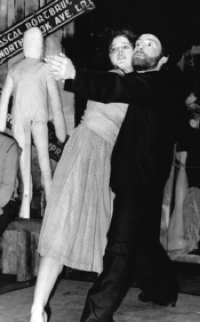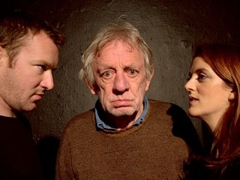The world was a very different place. The Berlin Wall had just fallen, Ireland was emerging from a major recession and it seemed there was nothing we couldn’t do. Bullaí Mhártain, a co-production between Deilt and Na Fánaithe, premiered in Druid Lane Theatre, Galway, in October 1989. I saw it later in Project Arts Centre, Dublin, and I thought it was extraordinary. Adapted by Seán Mc Carthy from stories by Donncha Ó Céilleachar and Síle Ní Chéileachair set in the Kerry Gaeltacht in the 1950s, it was directed by a Pole, Kazimierz Braun. Delivered in brief episodes, it relied on strong characterisation and intense physicality to put across its message. The director was obviously used to using a language which the audience would not all understand: he let the actors speak with their bodies and use the physical language suggested by the Gaeilge.
I thought it was telling me where Ireland was going. We were going to be fearlessly ourselves but in a European context. It may be hard for younger people to understand, but back then we felt like East Europeans, banging on the gates of Europe. Bullaí Mhártain seemed to open them. Nothing would do me but to interview Ray Yeates, who produced the show, for Theatre Ireland magazine, a precursor, in a way, to ITM. He said there was barely a theatre practitioner who wasn’t excited by the dramatic potential of the Irish language. I thought there was going to be an explosion of theatre in the Irish language.
But there wasn’t.
This month I went back to Ray Yeates, now Arts Centre Director of the Axis Theatre in Ballymun, and asked him what went wrong. He talks about the problem of funding for theatre in the Irish language – the problem being that there is funding for the Irish language, full stop: “There’s nothing wrong with looking for funding,” he says, “but it’s not an artistic position. You need people smoking cigarettes and fighting over a script.” He says that the approach to theatre in the Irish language should be European, not English. There’s no point just translating English theatre into Irish: “There must be something about the theatre in that language which is unique.”
But the big change that has come to the Irish language drama scene since early 1993 is TG4. Ray Yeates argues that the station has absorbed a lot of the talent that might otherwise have gone into theatre.
Irish Theatre Institute’s playography, Playography na Gaeilge, is an impressively scientific chronology of the 256 new plays in Irish (including adaptations and translations) between 1975 and 2009, which shows no correlation between the founding of TG4 and a decline in new theatre in Irish. It does show last year as having had the least productions in the whole period, down even on the first year, and it shows a spike around the Millennium.
 Actor, writer and director Diarmuid de Faoite – who founded Na Fánaithe in 1987, co-producers of Bullaí Mhártain – immediately cites the coming of TG4 as the biggest and most positive change that has come in the time. For example, he is currently working on four hours of original drama about a journalist working to expose the underbelly of Irish society, Corp agus Anam. His co-star is Maria Doyle Kennedy and the drama is directed by Darach Mac Con Iomaire, who was one of the most successful directors of An Taibhdhearc, in Galway, in recent times. The feed between stage and screen is clear. But more than anything else, TG4 has created a large pool of actors who are comfortable speaking Irish. Corp agus Anam has a cast of nearly seventy Irish speakers, de Faoite points out.
Actor, writer and director Diarmuid de Faoite – who founded Na Fánaithe in 1987, co-producers of Bullaí Mhártain – immediately cites the coming of TG4 as the biggest and most positive change that has come in the time. For example, he is currently working on four hours of original drama about a journalist working to expose the underbelly of Irish society, Corp agus Anam. His co-star is Maria Doyle Kennedy and the drama is directed by Darach Mac Con Iomaire, who was one of the most successful directors of An Taibhdhearc, in Galway, in recent times. The feed between stage and screen is clear. But more than anything else, TG4 has created a large pool of actors who are comfortable speaking Irish. Corp agus Anam has a cast of nearly seventy Irish speakers, de Faoite points out.
Nothing makes clearer the difference between stage and screen than thinking about drama in Irish, however. Very few situations exist in real life in which whole casts of characters speak in Irish, but television demands slices of life. In Corp agus Anam we are given to understand, as de Faoite says, that “Irish is the language of the world”. In theatre you needn’t spend time putting flesh on the bones of the language; you can play with the bones themselves.
Working through Playography na Gaeilge inevitably gives the reader a chance to x-ray the bones. It becomes clear that it is in Galway, not in Dublin, that theatre in the Irish language has thrived since 1975: there were 136 productions of new work in Galway in the period, and seventy-eight in Dublin. An Taibhdhearc in Galway city has been a big part of that, producing nearly forty-five per cent of the new shows in the period.
 Writing in the wake of the death of the actor Mick Lally, who came from An Taibhdhearc to co-found Druid Theatre Company, the impact of the Irish language on west coast theatre becomes obvious, an impact Druid’s Artistic Director, Garry Hynes, has always acknowledged. So you see Diarmuid de Faoite playing in Druid’s Synge cycle, ‘DruidSynge’; you also see The Cripple of Inishmaan by the Druid nursling, Martin McDonagh, appearing in Irish in An Taibhdhearc as Cripil Inis Meáin in a version by Mícheál Ó Conghaile. You could certainly say of Synge – and to a lesser degree of Mc Donagh – that their writing is a translation from the Irish already. No wonder they work when they return to the original.
Writing in the wake of the death of the actor Mick Lally, who came from An Taibhdhearc to co-found Druid Theatre Company, the impact of the Irish language on west coast theatre becomes obvious, an impact Druid’s Artistic Director, Garry Hynes, has always acknowledged. So you see Diarmuid de Faoite playing in Druid’s Synge cycle, ‘DruidSynge’; you also see The Cripple of Inishmaan by the Druid nursling, Martin McDonagh, appearing in Irish in An Taibhdhearc as Cripil Inis Meáin in a version by Mícheál Ó Conghaile. You could certainly say of Synge – and to a lesser degree of Mc Donagh – that their writing is a translation from the Irish already. No wonder they work when they return to the original.
For Clíodhna Ní Anluain, now a radio producer with RTÉ, who functioned as Director of the professional company Amharclann de hIde for five years from 1993, the productions of old Taibhdhearc versions of Synge, Pósadh an Tincéara (The Tinker’s Wedding) and Chun na Farraige Síos (Riders to the Sea) which toured to the western seaboard were highlights. The company held auditions in An Spidéal and two of the cast, Fionnuala Ní Fhlaithearta and Tom Sailí Ó Flatharta, went on to become regulars in the TG4 soap, Ros na Rún. Ní Anluain commissioned Eilis Ní Dhuibhne to write her first works in Irish, Dún na mBan trí thine (The Women’s Fort on Fire) and Milseog an tSamhraidh (Summer Sweet), and Ní Dhuibhne has gone on to become a prolific novelist in Irish.
Overall, however, if you ask Ní Anluain about Amharclann de hÍde, she says she wouldn’t have started from there. The company was set up by its co-funders, Bord Na Gaeilge and the Arts Council. The fact that Amharclann de hÍde wasn’t the initiative of artists was, she says, “a shadow” over it. Looking back, she says, the two state agencies should have just have given the money to Na Fánaithe: “They thought it was great that I had a room in Bord na Gaeilge. The first thing on my agenda was to get out of the place.”
County Galway is still where the action is in theatre through Irish. The Taibhdhearc venue was destroyed by fire three years ago, but there is a currently a fund-raising drive to rebuild it, and the company is still producing plays in different venues, under the management of Seamas Ó hAodha, artistic and marketing manager. But An Taibhdhearc’s record is patchy and some feel that the fact that it is funded directly by the Department of the Gaeltacht, rather than through the usual Arts Council channels, doesn’t help.
When you explore what’s happening in County Galway, you realise that most of what Ray Yeates laments is not happening is happening – it’s just that information and recognition are slow to come. TG4 has created a hub of creative people who are open to new media and the ancient traditions of European theatre. They are making theatre in Irish. Salamander Theatre Company was founded in Connemara by Darach Ó Scolaí in 2006. Branar, a theatre-in-education company, was founded, also in Connemara, by Marc Mac Lochlainn in 2001. I have not seen the company’s work, but Diarmuid de Faoite speaks excitedly about the links they have forged with similar companies in Denmark, and their work with puppets.
Ray Yeates describes the Connemara-based company, Fíbín, as “the closest to what I think the future is.” Founded in 2003, Fíbín – which means “an explosion of joy and happiness” – grew straight out of TG4. Its founder, Darach Ó Tuairisg, was recruited to go on a course to create live-action puppetry links for the Irish version of The Hoobs, and was taught by Jim Henson’s company. He got together with people such as Rod Goodall (ex-Footsbarn theatre company) and the ace mask-maker, Matthew Guinnane.
Ó Tuairisg says he is up against the negativity caused by theatre done in Irish “for the sake of it”: “The dresser in the corner. Crap.” Fíbín’s productions have included the recent An Rón Dall (The Blind Seal), a version of a Mayo folktale, using original music by Vinnie Kilduff and visuals by artist Dara Mc Gee. The show has been invited to France and Belguim. They are about to tour two adaptations, An Cearrbhach Mac Cába and Fiche Bliain ag Fás (tour dates on www.fibin.com). Fíbín have also commissioned Paul Mercier to write a version of An Táin for them – Mercier founded the English-language theatre company Passion Machine in the 1980s. Mercier also wrote the cutting-edge teen soap Aifric for TG4, produced by Mícheál Ó Domhnaill, who has recently joined Fíbín.
None of Fíbín’s work is in Playography na Gaeilge, because it is categorised as puppetry, which is not included. Yet the work uses many media, in fact, as well as puppetry, and, in any case, why should puppetry be excluded? If Fíbín’s work were included, the whole picture would look different. The Playography is not definitive, however; it is organic, and if there were no shouts that something had been left out, it would be a sign that no-one was breaking any boundaries. Instead, the creative people within theatre through Irish are refusing to play by any rules.
“Nothing can ever be done for the sake of it. Ever,” says Clíodhna Ní Anluain. “All that matters is the energy and vision of the creative person and their need to do it. Sin é mo scéal.”
www.irishplayography.com
Victoria White is a writer and journalist based in Dublin. See her accompanying article on the creation of Irish Theatre Institute’s Playography na Gaeilge.